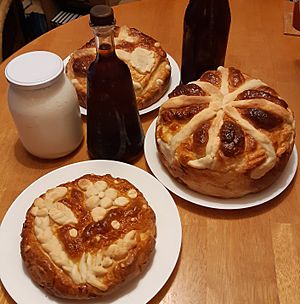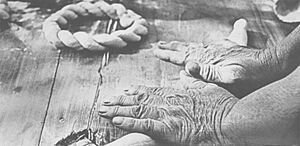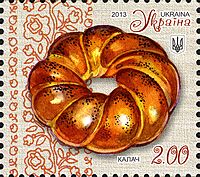Kolach (bread) facts for kids
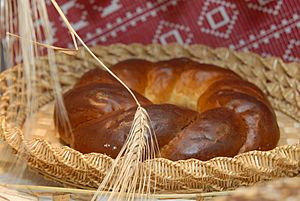 |
|
| Alternative names | Kalach, Korovai, Karavai |
|---|---|
| Type | Sweet or savoury bread, ceremonial cake |
| Place of origin | Belarus, Bulgaria, Hungary, Moldova, Poland, Romania, Russia, Serbia, Ukraine |
| Region or state | Eastern Europe |
| Created by | Early Slavs |
| Main ingredients | Wheat or rye flour |
Kolach (pronounced KOH-lach) or kalach is a special kind of bread. It is popular in countries across Central and Eastern Europe. People often eat it during important celebrations and traditions. Its name comes from an old Slavic word, kolo, which means "circle" or "wheel." This is because many kolaches are shaped like a circle. Sometimes, another special bread called Korovai is seen as a type of kolach.
Contents
What's in a Name?
The name "kolach" changes a little bit in different countries. But its main meaning always comes from the old Slavic word for "circle." This refers to the round shape of the bread.
For example, people say "kolač" in Bulgaria, Macedonia, and Ukraine. In Poland and Silesia, it's "kołacz." In Romania, it's "colac," and in Serbia, it's "kolač."
Another similar bread is called "korovai" or "karavai." Even though it looks like kolach, its name comes from a different origin. In some places, like Poland, "korowaj" is a very fancy type of kolach.
It's interesting that in the Czech Republic and Slovakia, "kolač" means a different kind of cake. It's not the same bread. But in Poland and Serbia, "kołacz" or "kolač" can also mean different cakes.
Kolach Traditions Around Europe
Kolach and korovai breads are used in many similar ways. They share customs, especially among Slavic nations. But there are also differences between countries and even within regions.
Kolach in Belarus
In Belarus, kolach is an important part of celebrations. It is often used at weddings. Here, it is known as "kalach" or "kravai." This bread shows hospitality, good luck, and respect. It is often decorated with small figures and flags. The kravai is usually savory and sometimes dipped in salt.
Kolach in Hungary
The Hungarian kalács (pronounced KAH-latch) is a sweet bread. It is very similar to a French brioche. It is usually baked in a braided shape. People traditionally eat it during Easter.
In the past, kalács was made like everyday bread. The main differences were its shape and the better flour used. Today, kalács dough is made richer with milk and eggs. It is baked in an oven, sometimes directly on hot stones.
Kalács is a traditional Easter food in Hungary. It is often blessed in Catholic churches along with ham. In some areas, plain kalács was given to beggars on All Saints' Day. This was a Christian way of continuing an old tradition of honoring the dead.
Kolach in Poland
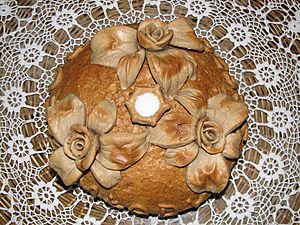
The first records of a special bread called kołacz or korowaj at Polish weddings go back to the early 1200s. This means the tradition of baking these sweet breads is very old in Poland. Today, it is also made for harvest festivals (Dożynki), Christmas, or Easter.
Studies show that making kołacze (the plural of kołacz) is still common in many rural areas of Poland. However, how it's made can differ from village to village. Some kolache have tasty fillings. These can include white cheese, poppy seeds, raisins, or dried plums. They might be topped with powdered sugar or more poppy seeds.
Kołacz is often decorated, especially for special events. Korowaj is almost always very fancy. It often has decorations like a bird's nest in the middle, surrounded by braids, grain ears, birds, or flowers.
Long ago, a writer named Zygmunt Gloger said that Polish kolach came in many types. They were usually made from wheat or rye flour. He believed the name and traditions of kołacz were shared by all Slavic people. In Poland, there was an old tradition where noble ladies would sing and dance around the kołacze placed on a table.
Many regional types of sweet bread called kołacz or korowaj are officially recognized in Poland. The Polish Ministry of Agriculture says that making kolach has been a custom in eastern Poland since the Middle Ages. It is also celebrated by Serbs, Bulgarians, Ukrainians, and Belarusians.
There are many old sayings and rhymes about kolach in Polish culture. This shows how important this sweet bread and its traditions have been for centuries. In some parts of Silesia, kolach is called kołocz. It is made for other holidays like Dożynki, as well as weddings. Armenian communities in Poland also make kolach for holidays, but they add saffron to it.
Kolach in Romania and Moldova
In Romania and Moldova, colac is a braided bread. It is usually made for special events or holidays. These include Christmas, Easter, weddings, and funerals.
During Christmas Eve, groups of people in Romanian villages sing traditional Christmas carols called colinde. Families invite them inside and give them small gifts. These gifts often include nuts, dried fruits, and colacs.
The word colac comes from the Slavic word kolač. This word also comes from kolo, meaning "circle" or "wheel," because of its round shape.
Kolach in Russia
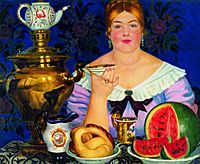
In Russia today, kalach means a specific type of twisted white bread. In the past, it meant any kind of white bread. Before modern ways of grinding wheat, white bread was considered a fancy bread.
Kalach usually looks like a circle. But one part is much thinner, and another part is much thicker. The thinner part was used as a "handle." This way, workers could eat the bread without washing their hands. After eating, the handle was thrown away or given to poor people.
Only very poor people would eat these thrown-away handles. This is why there's a Russian saying, "go down to the handle." It means to hit rock bottom or have a very bad setback.
A person who made kalaches was called a kalachnik. This name sometimes changed to kalashnik. People with the last name Kalachnikov or Kalashnikov are descendants of these bread makers.
Kolach in Serbia
In Serbia, the kolač is a traditional yeast bread. It is generally thought of as a cake. Unlike in Poland, where it's for weddings, in Serbia, kolač is used only for the Orthodox Christian celebration of Slava. That's why it's called Slavski kolač.
During Slava, a priest visits the family. He blesses the kolač and red wine. He also lights a beeswax candle with the family's patron saint on it.
The Slavski kolač is a round, yeast bread cake. It is about 15 centimeters (6 inches) high. Traditionally, braided dough is wrapped around the edge. A dough cross is pressed into the middle, dividing the bread into four parts. Each part gets more decorations. For example, a Cyrillic "C" might be used. This stands for "only unity will save the Serbs." Around the edge, Cyrillic letters "ИС ХС НИ КА" are placed. This is short for "Jesus Christ Conquers." Each baker has their own way of decorating the bread.
Kolach in Ukraine
Ukrainian kolaches are made by braiding wheat flour dough. They can be ring-shaped or long. They are a symbol of good luck, wealth, and plenty. They are traditionally made for Svyat Vechir (Holy Supper), which is the Ukrainian Christmas Eve meal.
For Christmas kolach, three braided loaves of different sizes are stacked. This represents the Trinity. The bread's circular shape stands for eternity. A candle is placed in the center of the braided loaves for Christmas dinner. But the bread cannot be eaten until Christmas Day. This is because people fast during Advent and avoid eggs until midnight on Christmas Eve.
For funerals, kolach loaves are brought to church to be blessed. Then they are served in slices with fresh fruit. This symbolizes the good things the person did in their life. Customs can vary. For example, three loaves might be decorated with three apples, three oranges, and grapes. A candle is placed in the center. Sometimes, a small individual loaf is given.
Near Kyiv, it was a custom for a midwife to give a kolach as a gift to new parents. This was a blessing for fertility. Kalaches were also used in funeral ceremonies. In other regions, children would give them to their godparents in a ceremony called kolachyny.
The Bread Museum in L'viv, Ukraine, has many examples of beautifully woven kalach, paska, and babka breads.
|
See also
 In Spanish: Kalach (comida) para niños
In Spanish: Kalach (comida) para niños


